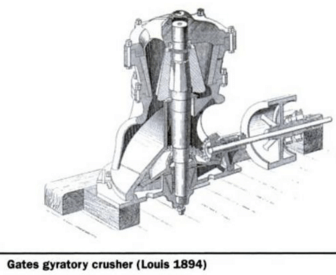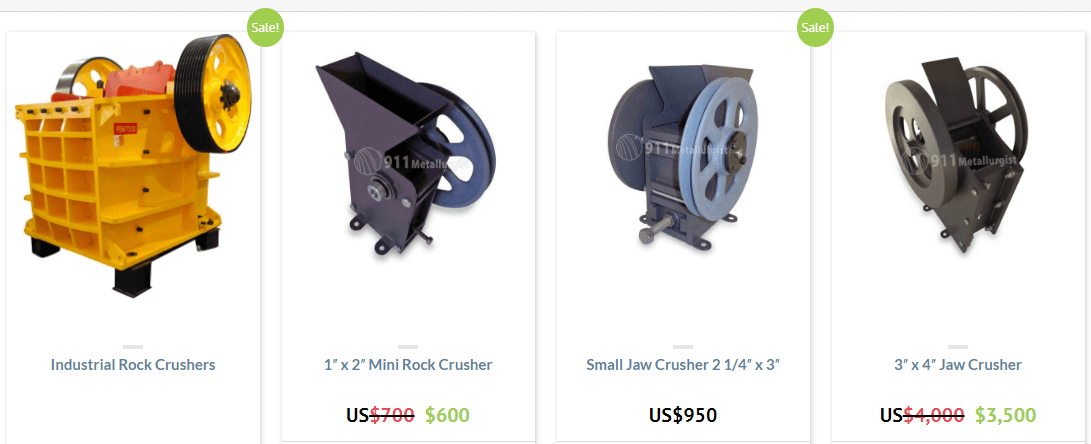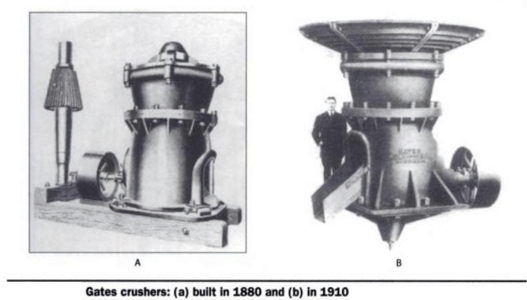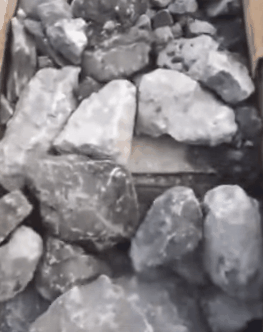History tells us, it was in 1830, the first US patent was issued on a rock crushing machine. It covered a device which, in a crude way, incorporated the drop hammer principle later used in the famous stamp mill, whose history is so intimately linked with that of the golden age of mining. In 1840, another patent was issued, which comprised a wooden box containing a cylindrical drum apparently of wood also on which a number of iron knobs, or hammers, were fastened; the expectation was that this drum, when revolved at about 350 RPM, would shatter the rock fed into the top of the box. This device, although it was conceived as an impact crusher and thus would rate as a forerunner of the hammermill, bore a somewhat closer resemblance to the single sledging-roll crusher. There is no evidence that either of these early inventors carried their work through to fruition.
Eli Whitney Blake invented the first successful mechanical rock breaker, the Blake jaw crusher patented in 1858. Blake adopted a mechanical principle familiar to all students of mechanics, the powerful toggle linkage. That his idea was good is attested to by the fact that the Blake type jaw crusher is today the standard by which all jaw crushers are judged, and the leading machine of the class for heavy duty primary crushing service.
The gyratory principle was the basis of several rudimentary designs, patented between 1860 and 1878, none of which embodied practical mechanical details at least, not in the light of our present-day knowledge of the art. Then, in 1881, Philetus W. Gates was granted a patent on a machine which included in its design all of the essential features of the modern gyratory crusher. The first sale on record antedates the patent by several months, a No. 2 crusher, sold to the Buffalo Cement Co. in 1880. That was the first of several thousand gyratory crushers which carried the name of Gates to the far corners of the earth.
An interesting sidelight of these early days occurred in 1883 when a contest was staged between a Blake jaw crusher and a Gates gyratory crusher. Each machine was required to crush 9 cubic yard of stone, the feed-size and discharge settings being similar. The Gates crusher finished its quota in 21 minutes, the Blake crusher in 65 minutes, which must have been a sad disappointment to the proponent of the Blake machine, who happened to be the challenger.
For some years after these pioneer machines were developed, requirements, viewed in the light of present practice, were very simple. Mining and quarrying, whether underground or open-pit, was done by hand; tonnages generally were small, and product specifications simple and liberal.
In the milling of precious metal ores, stamp mills were popular as the final reduction machine. These were generally fed with an ore size that could be produced handily by one break through the small gyratory and jaw crushers which served as primary breakers. Even in large underground mining operations there was no demand for large crushers; increased tonnage requirements were met by duplicating the small units. For example, in 1915, at the huge Homestake operation, there were no less than 20 Gates’ small gyratory crushers sizes No. 5 and 6 to prepare the ore for the batteries of >2500 stamp mills.

Most commercial crushed stone plants were small, and demand for small product sizes practically non-existent. Many plants limited output to two or three products. Generally the top size was about 2.5 to 3″ ring-size; an intermediate size of about 1.5″ or thereabouts, might be made, and the dust, or screenings, removed through openings of about 0.25″. In ballast plants the job was even more simple, one split and an oversize re-crush being all that was needed.

Many small process plants consisted of one crusher, either jaw or gyratory rock crushers, one elevator and one screen. Recrushing, if done, was taken care of by the same machine handling the primary break. The single crusher, when of the gyratory type, might be any size from the No. 2 (6″ opening) to the No. 6 with 12-in. opening.

When demand grew beyond the capabilities of one crusher, it was generally a simple matter to add a second machine to take care of the recrushing or secondary crushing work. A popular combination, for example, consisted of a No. 6 primary and a No. 4 secondary, or possibly a 20- x 10-in., or 24- x 12-in. primary jaw, followed by one of the small gyratories. When the business outgrew the capacity of this sort of plant, it was not unusual to double up, either in the same building, or by erecting an entirely separate plant adjacent to the original one.
Crusher manufacturers were not standing still during these early years. In the gyratory line, for example, the No. 2 was the first popular size, and larger machines were developed from time to time up to the No. 6, then the No. 7.5
https://www.911metallurgist.com/blake-jaw-crusher
The steam shovel began to change the entire picture of open-pit working. With the steam shovel came the really ‘‘huge” No. 8 crusher, with its 18″ receiving opening. Up to this time the jaw crusher had kept pace with the gyratory, both from the standpoint of receiving opening and capacity, but now the gyratory stepped into the leading position, which it held for some 15 years. Once the ice was broken, larger and larger sizes of the gyratory type of crusher were developed rapidly, relegating the once huge No. 8 machine to the status of a secondary crusher. This turn toward really large primary crushers started just a few years before the turn of the century, and in 1910 crushers with 48″ receiving openings were being built. Along about this time the jaw crusher suddenly came back to life and stepped out in front with a great contribution to the line of mammoth-size primary crushers: the 84″ x 60″ machine built by the now Joy Mining Machinery for a trap rock quarry in eastern Pennsylvania. This big crusher was followed by a No. 10 (24″ opening) gyratory crusher for the secondary break. Interest created by this installation reawakened the industry to the possibilities of the jaw crusher as a primary breaker, and lines were brought up-to-date to parallel the already developed gyratory lines.
Along about this time the jaw crusher suddenly came back to life and stepped out in front with a great contribution to the line of mammoth-size primary crushers: the 84″ x 60″ machine built by the now Joy Mining Machinery for a trap rock quarry in eastern Pennsylvania. This big crusher was followed by a No. 10 (24″ opening) gyratory crusher for the secondary break. Interest created by this installation reawakened the industry to the possibilities of the jaw crusher as a primary breaker, and lines were brought up-to-date to parallel the already developed gyratory lines.
 Although his machines never came into general use in the industry, Thomas A. Edison ranks as a pioneer in the development of the large primary breaker and credited with the announcement of a very interesting and constructive bit of reasoning, which was the basis of his development. Concerned at the time with the development of a deposit of lean magnetic iron ore where he was using a number of the small jaw crushers then available for his initial reduction. Realizing that to concentrate this ore at a cost to permit marketing it competitively meant cutting every possible corner, he studied the problem of mining and crushing the ore as one of the steps susceptible of improvement.
Although his machines never came into general use in the industry, Thomas A. Edison ranks as a pioneer in the development of the large primary breaker and credited with the announcement of a very interesting and constructive bit of reasoning, which was the basis of his development. Concerned at the time with the development of a deposit of lean magnetic iron ore where he was using a number of the small jaw crushers then available for his initial reduction. Realizing that to concentrate this ore at a cost to permit marketing it competitively meant cutting every possible corner, he studied the problem of mining and crushing the ore as one of the steps susceptible of improvement.
In approaching the problem, Edison reasoned that the recoverable energy in a pound of coal was approximately equal to the available energy in one pound of 50% dynamite; but the cost per pound of the dynamite was about 100 times that of the coal. Furthermore, a large part of the dynamite used in his mining operation was consumed in secondary breaking to reduce the ore to sizes that the small primary crushers would handle. The obvious conclusion was that it would be much cheaper to break the large pieces of ore by mechanical rather than by explosive energy.
With that thesis as a starting point, he set out to develop a large primary breaker, a development which culminated several years later in the huge and spectacular 8′ x 7′ Edison rolls. A description of the action of this machine will be found in a later section of this series. During the early years of the present century these giant machines created considerable interest, and several were installed in this country. However, they never became popular, and interest swung back to the more versatile gyratory and jaw types. Edison rolls were also developed in smaller sizes for use as secondary and reduction crushers. In his own cement plant Edison used four sets of rolls operating in series to reduce the quarry-run rock to a size suitable for grinding.
https://www.911metallurgist.com/secondary-gyratory-crushers

